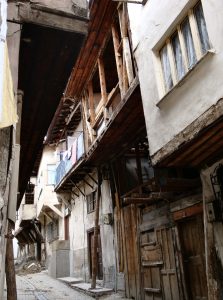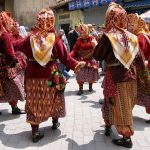Day-trip from Ankara Population: 65,500
Old name: Gangra, Germanicopolis (Roman)
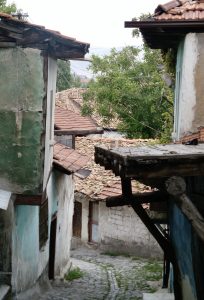 If you’re staying in Ankara you can easily make a day trip to Çankırı, just an hour and a half to the north, which boasts attractions ranging from an old Selçuk mescid (chapel), through a collection of fine Ottoman houses and mosques, to what is billed as a cave but is actually an enormous salt mine.
If you’re staying in Ankara you can easily make a day trip to Çankırı, just an hour and a half to the north, which boasts attractions ranging from an old Selçuk mescid (chapel), through a collection of fine Ottoman houses and mosques, to what is billed as a cave but is actually an enormous salt mine.
Around town
As so often, initial impressions are somewhat misleading. Çankırı high street is a long canyon of concrete shop-cum-housing blocks. One of those blocks, however, houses a small museum which is the best place to start your explorations. Here you will be able to inspect the evidence of the city’s long history which predates the Hittites. They, however, left the town it’s most significant antiquarian object- a huge red-clay vase decorated with images of a wedding. The original is now in the Ankara Museum of Anatolian Civilisations while an even larger copy stands near the bus station as a symbol of the town.
The museum is in need of a makeover, although one room does display a collection of beautifully lit glass bottles dating back to Roman times when Çankırı was called first Gangra and then Germanicopolis.
Duck behind the museum, head towards the Tatlıçay river and hopefully you will come out near the Taş Mektep, an imposing stone-built schoolhouse dating back to 1886 in which Atatürk stayed when on tour to promote the Hat Law abolishing the fez in favour of hats. It now serves as a Fine Arts High School.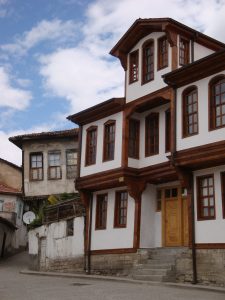
Immediately across the road from the Taş Mektep stand a row of beautifully painted Ottoman houses, one of which used to contain a post office and library but has now been restored as a model “Yaran Evi”, a place where men would meet to talk, somewhat in the way that they did during the better known sıra gecesis of Şanlıurfa in the southeast. A yaran gecesi lasted from just after evening prayers until just before dawn prayers, and offered an opportunity for men not just to have fun together but also to discuss pressing problems.
Today the Yaran Evi is more like a private dining club with a small museum in memory of Mustafa Soydan, a prominent local journalist, on the ground floor.
If you cross the river, head north and then turn left along Taş Mescit Caddesi you will come to Çankırı’s most venerable site, the fortress-like Taş Mescit (Stone Chapel) which dates back to 1235 and the reign of the great Selçuk king Alaeddin Keykubad.
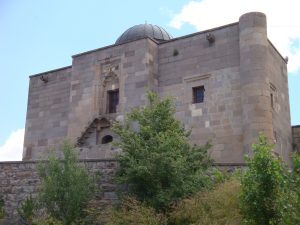 Originally it formed part of a collection of buildings including a hospital and seminary paid for by the local governor, Cemalettin Feruh, whose tomb can be seen inside it. As is usual with Selçuk structures, its most impressive external feature is the elaborately carved doorway, accessed via a double staircase, but in the triangle beneath the steps there’s an extraordinary single carving of two snakes entwined around each other. A symbol of medicine, it must have came originally from the hospital, which has since been lost, along with a cup with a snake wrapped round it symbolising pharmacy that can be seen in the museum. The building eventually became a dervish lodge. Today it’s a small mosque.
Originally it formed part of a collection of buildings including a hospital and seminary paid for by the local governor, Cemalettin Feruh, whose tomb can be seen inside it. As is usual with Selçuk structures, its most impressive external feature is the elaborately carved doorway, accessed via a double staircase, but in the triangle beneath the steps there’s an extraordinary single carving of two snakes entwined around each other. A symbol of medicine, it must have came originally from the hospital, which has since been lost, along with a cup with a snake wrapped round it symbolising pharmacy that can be seen in the museum. The building eventually became a dervish lodge. Today it’s a small mosque.
Those with energy might like to divert north along the banks of the Tatlıçay and climb the hill to the remains of Çankırı Kalesi (castle), bypassing on the way a modern mosque named after Emir Karatekin Bey, the chieftain who in 1074 captured Çankırı and neighbouring towns for the Selçuks.
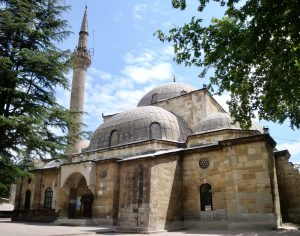 Otherwise you can return to the town centre in search of the Büyük Cami (Great Mosque), also known as the Sultan Süleyman Cami because it was built in 1558 during the reign of Sultan Süleyman the Magnificent by Sadık Kalfa, an architect who had studied under the great Mimar Sinan. Beside it stands the attractive and newly restored Çivitçioğlu Medresesi, dating back to 1754 and half-heartedly open as an ethnographic museum.
Otherwise you can return to the town centre in search of the Büyük Cami (Great Mosque), also known as the Sultan Süleyman Cami because it was built in 1558 during the reign of Sultan Süleyman the Magnificent by Sadık Kalfa, an architect who had studied under the great Mimar Sinan. Beside it stands the attractive and newly restored Çivitçioğlu Medresesi, dating back to 1754 and half-heartedly open as an ethnographic museum.
Pretty as it is the Çivitçioğlu is outstripped in the beauty stakes by the Buğdaypazarı (Wheat Market) Medresesi, a graceful galleried building that runs along one side of a courtyard in front of the Buğdaypazarı Cami.
The Buğday Pazarı (Wheat Market) stands at the heart of the part of Çankırı where most of the lovely old Ottoman houses can be found. A few have been restored or patched up, but many are in a poor state of repair, their owners long since moved on to more comfortable lives in Ankara and İstanbul.
As you wander around you may stumble upon a rather ugly, concrete-faced wooden clocktower possibly dating back to 1886 but possibly commemorating the twenty-fifth anniversary of Sultan Abdülhamid’s accession to the throne in 1901.
You may even stumble on an unusual restoration, a communal laundry (çamaşırhane) dating back to 1885 and in use until 1980 that was recently given new life as an events hall.
Sleeping
There are not a lot of hotels to choose from in Çankırı. Best and most central used to be the Sim Prestige which has refurbished rooms on the lower floors, and cheaper, more old-fashioned ones higher up.
Çankırı Büyük Otel. Tel: 0376-213 3838
Joyana Hotel. Tel: 0376-213 5757
Sim Prestige Oteli. Tel: 0376-213 1200
Transport info
There are hourly buses to Çankırı from Ankara bus station (AŞTİ), although onward connections to Kastamonu are less frequent. Nor do they come into Çankırı bus station which means that you will be driven out to meet them.
Taxi drivers at the bus station know the way to the Tuz Mağarası (Salt Cave).
Day trip destinations
